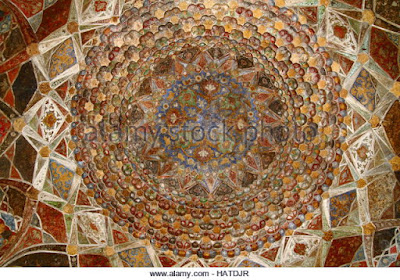 |
| Chini-ka-rauza, Agra. en.wikipedia.org |
 |
| Chini-ka-rauza, Agra. in.pinterest.com/ |
Besides the Taj, there are many Islamic monuments in the historic city of Agra, near Delhi and among them Chini Ka Rauza is an important one. The distinctive feature of this monument is the glazed-tile ornamentation that is believed to have been brought all the way from China; hence the name. What makes the monument significant is the artwork and colour embellishments on it. Here, the tomb is dedicated to Allama Afzal Khan, who was the Prime Minister and poet during the times of Mogul emperor Shah Jahan. He was a Persian poet during the reign of Jahangir. Later he became the Wazir during Shah Jahan's rule. Khan died in Lahore in 1639, but was buried here at Agra. His mausoleum was built facing the city of Mecca. It is also known as China Tomb,
 |
| Chini_Ka_Rauza, Agra. colorful ceiling. Alamy. com |
 |
| Interior, Chini_Ka_Rauza, Agra. egoldentriangle.com/ |
The tomb part is in Afghan style, however the main and dominant style is that of Persian. Rectangular in design, it is made of brown stones nicely mixed with colorful ceramic tiles. There were two gates for the tomb - one in the north and the other in the south. It was once a three-story tower in octagonal shape near the ghat. Unfortunately because of vagaries of climate and time span, many parts are in ruins; however, the main tomb is survived. Various enamel colors have become faded away for the same reason - unfriendly weather. The arches are nicely decorated with intricate designs and have orange and blue tiles. The brackets, chajja and balconies are well embellished and the color combination is the main attraction. Colourful tiles nicely adorn the whole tomb and the interior design was a mesmerising one. Winter season is the right time to visit Delhi and adjacent cities as the summer is pretty hot.
https://en.wikipedia.org/wiki/Chini_Ka_Rauza
https://www.mapsofindia.com/agra/chini-ka-rauza.html






.jpg)


